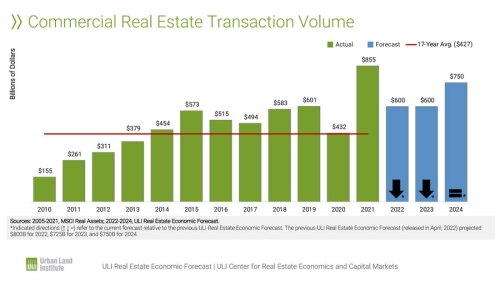Companies’ eagerness to reduce their real estate costs by shrinking the space allotment per employee, coupled with economic shifts and changes in the nature of work that reduce the need to be on site, have radically altered the office space market in recent years. But while those long-term trends continue, they may be starting to bump up against practical limits, according to experts on a panel at the 2018 ULI Spring Meeting in Detroit.
Companies may be starting to see that squeezing more employees into less space is starting to be counterproductive, said John Buza, managing director and head of U.S. asset management for Morgan Stanley. He described seeing office facilities so densified that rows of workers wore headphones as they leaned over their computer screens, in an effort to screen out distractions.
“The initial swing was too far,” Buza explained. “People are coming back and adding a little more space.”
Densification can bring added costs, too. Mark Kapicak, a program manager on the North American leasing team of IBM’s Real Estate Strategy and Operations, noted that in one Toronto building, IBM ended up having to install additional bathrooms to accommodate 326 people working in a space that once held 200.
Even so, panelists agreed that expansive offices were largely a thing of the past, especially with wireless communications and cloud-based applications increasingly allowing employees to get much of their work done off site.
“Rest assured that 300 square feet [28 sq m] [per employee] is going away,” said Mark Gilbreath, founder and chief executive officer of LiquidSpace, a San Francisco–based shared-economy marketplace for meeting and work spaces that he described as an Airbnb for offices.
Kapicak said that IBM is shifting the way it thinks about office space to focus more on what tasks employees need to perform, rather than on how much square footage each should get. That entails creating “neighborhoods” within offices, where a worker can go to do certain tasks, whether the task is making phone calls or collaborating with others.
“It’s really about thinking differently about doing the work in that space,” Kapicak said.
Panel moderator Jean Chick, a principal in real estate and location strategy for Deloitte Consulting, sketched out a similar vision, in which employees customized their workspace requirements, depending on what they needed to do on a particular day. “We’re creating a work environment that’s flexible,” she said.
But while the remote-working trend continues, some employers are rethinking the practice. Kapicak noted that IBM, for example, is bringing some remote workers back on site. “We’re encouraging people to come back to facilitate collaboration,” he explained.
Gilbreath said that companies may opt to allow employees to book remote days while still having a desk at the office, and that workers increasingly will think of their job as having multiple locations.
Companies are also increasingly seeking greater flexibility in their leasing arrangements, as well as plenty of amenities favored by millennial workers, such as coffee bars, food courts, and walking trails.
Buza said that Morgan Stanley is spending $57 million on amenities for one building in Chicago that it is renovating. As a result, Morgan Stanley was quickly able to sign a major tenant that is taking at least 460,000 square feet (43,000 sq m) of space, he said. In addition, he said, “some of the existing tenants saw what we were doing and did early renewals.”
Gilbreath envisioned continued momentum for flexible arrangements in which companies market their unused capacity through an online platform such as LiquidSpace, which he says offers 25,000 locations that can be obtained for as little as an hour, or for longer periods. A business “really can have infinite locations,” he said.
Flexible office space and coworking providers such as WeWork form a sector that has been growing at a
23 percent annual rate since 2010, according to research released in December by commercial real estate services and management firm JLL. In the past two years, flexible/coworking space has accounted for close to 30 percent of total U.S. office absorption.
Panelists said that companies are hindered in trying to optimize their space needs by the difficulty of measuring how employees actually use it. Kapicak said that IBM still relies upon identification-card swipes to measure utilization, as well as visual counts, but is starting to get into using sensing technology as well. “We’re pushing space providers for more accurate utilization data,” he said.



